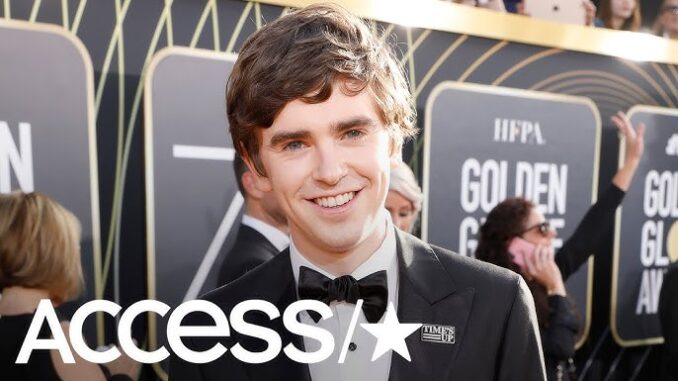
Season after season, Freddie Highmore has delivered an emotionally resonant, deeply nuanced portrayal of Dr. Shaun Murphy on The Good Doctor — but it was in Season 5 that his performance truly ascended to another level. With the stakes higher, relationships evolving, and Shaun facing some of the most emotionally complex situations of his life, Highmore’s ability to capture quiet strength, vulnerability, and internal conflict was nothing short of extraordinary.
Season 5 wasn’t about Shaun proving he could be a surgeon — we already knew that. It was about proving he could navigate the personal world with just as much courage as he does the operating room. And through every pause, every flicker of emotion, and every line delivered with surgical precision, Freddie Highmore made us believe it. From the beginning of The Good Doctor, Shaun was presented as a brilliant young man with autism and savant syndrome, whose unorthodox way of processing the world created both conflict and inspiration within his hospital. But by Season 5, the focus had shifted — not on whether Shaun could function in the high-pressure environment of medicine, but on whether he could thrive emotionally in a world that often demands conformity.
This season brought Shaun face-to-face with challenges that would rattle anyone: relationship difficulties with his longtime partner Lea, workplace politics, a shifting leadership structure, and the pressure of looming marriage. These weren’t just plot points — they were tests of emotional endurance. And Highmore handled them all with an internal richness that spoke louder than any dramatic monologue could.
What sets Highmore apart isn’t just his ability to portray autism with empathy and respect — it’s the way he brings the audience into Shaun’s inner world without overselling it. Season 5 saw numerous moments of silence and stillness, where Shaun’s facial expressions told us everything we needed to know. In episodes like “Rebellion” and “One Heart,” we saw Shaun struggle with feelings of betrayal, frustration, and helplessness. But instead of resorting to melodrama, Highmore used restraint. When Shaun is devastated, his lips don’t quiver dramatically. His voice doesn’t crack. He simply… freezes. His hands tremble ever so slightly. His eyes dart. And in those tiny, calculated gestures, we see an emotional avalanche underneath.
This subtlety is what makes Highmore’s performance so masterful. He doesn’t perform autism — he embodies Shaun, fully and respectfully, honoring the spectrum rather than dramatizing it. One of the emotional pillars of Season 5 is Shaun’s relationship with Lea. After navigating several ups and downs in Season 4, the couple entered Season 5 engaged — but happiness was far from guaranteed. Freddie Highmore portrayed Shaun’s growing pains within the relationship with honesty and vulnerability. Whether it was Shaun’s discomfort over Lea manipulating patient reviews to protect him, or his confusion and devastation when trust began to erode, Highmore delivered performances that felt deeply personal, never theatrical.

The proposal, the therapy sessions, the fights — each moment was performed with grounded intensity. Highmore understood the weight of Shaun’s love for Lea and how deeply betrayal, even well-intentioned, can shake him. That emotional turmoil wasn’t explosive. It simmered — and that made it even more impactful. Season 5 also pushed Shaun into new professional territory. He faced new leadership at the hospital, including Salen Morrison (played by Rachel Bay Jones), whose profit-first approach clashed with his values. Highmore’s portrayal of Shaun’s increasing disillusionment with the hospital’s new direction was both subtle and riveting. Instead of shouting down Salen or delivering long speeches, Shaun resisted in his own way — by walking out of meetings, refusing to cut corners, and standing firm in his ethics. These moments allowed Highmore to showcase Shaun’s quiet defiance and his growing moral confidence.
Freddie Highmore has long been praised for portraying Shaun in a way that’s respectful, authentic, and grounded. But Season 5 was perhaps the show’s most important year in terms of deepening public understanding of autism and neurodivergence. Shaun isn’t painted as perfect, nor is his autism used as a gimmick. Instead, Highmore allows Shaun to be human — brilliant but flawed, empathetic yet confused, confident in his knowledge but often unsure of how to navigate emotional landscapes. His portrayal dismantles stereotypes and invites viewers to see the world through Shaun’s eyes.
For many neurodivergent viewers and their families, Highmore’s work is more than compelling acting — it’s representation they’ve rarely seen in prime-time television. As the season progressed, Shaun and Lea’s wedding became a central emotional arc — and it tested Shaun’s resilience like never before. Highmore’s performance during the lead-up to the wedding was layered with anxiety, fear of imperfection, and the ever-present worry that something would go wrong.
When the wedding finally does happen in the season finale, it’s not a grand cinematic moment. It’s small. Intimate. Honest. And that makes it perfect. Highmore’s smile as Shaun sees Lea walking down the aisle is one of the most emotionally authentic moments of the entire series. It feels earned. By the end of Season 5, it’s clear that Freddie Highmore has transcended the role of “former child star.” He’s no longer the kid from Finding Neverland or the unsettling teen from Bates Motel. He’s a fully matured actor delivering career-defining work in a role that will likely be remembered as one of the best performances in network drama of the last decade.
Season 5 demanded everything from Highmore — emotional dexterity, subtle physical acting, ethical conviction, and romantic vulnerability. And he delivered it all with grace and precision. Freddie Highmore’s performance as Dr. Shaun Murphy in The Good Doctor Season 5 was not only his most emotionally expansive to date — it was also his most human. Through a masterclass in restraint, empathy, and complexity, he continued to break barriers in how autism is portrayed on television. More than that, he reminded viewers that heroes don’t always wear capes — sometimes, they wear scrubs, carry surgical tools, and struggle just like the rest of us.
